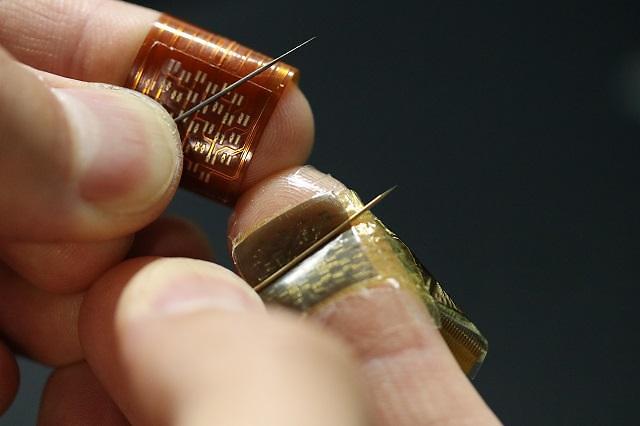
[Courtesy of the Electronics and Telecommunications Research Institute]
SEOUL -- Telehaptics refers to the transmission of computer-generated tactile sensations over networks. Telehaptic systems transmit a sophisticated and near-realistic sense of touch from one user to another. The core capability of telehaptic transducers depends on precisely monitoring the spatiotemporal and physical deformations occurring on soft skin surfaces and reproducing them from a distance.
Telehaptic systems must satisfy the collection and reproduction performance of sophisticated tactile information and functional needs to minimize the feeling of irritation and discomfort. Sensors and actuators should be designed to have mechanical flexibility and skin conformability so that tactile stimuli can be detected or reproduced without interfering with the function of natural hands.
The state-run Electronics and Telecommunications Research Institute (ETRI) said its team led by Kim Hye-jin, a senior researcher at ETRI's intelligent sensor lab, has developed a telehaptic device that remotely transmits touch in real time by attaching it to fingertips to provide a vivid tactile experience. It can add immersion to virtual and real-life tactile experiences with the world's best performance and usability through miniaturization.
By upgrading the performance and form factor of piezoelectric devices, Kim's team would create a composite touch and texture that is the same as reality by combining vibration and various types of tactile stimuli. "The light and flexible on-skin tactile reproduction device that can be attached to the skin has taken a step further to establish a foundation for immersive augmented reality content development," Kim said in a statement.
Using Bluetooth communication, real-time tactile reproduction is possible at a distance of up to 15m, ETRI said. The research team demonstrated an ultra-flexible tactile interface with high spatial resolution for telehaptic communication on human skin.
Dual mechanism sensors and sub-mm scale piezoceramic actuators were designed to record and generate static and dynamic pressures in a wide frequency range, while actuators were integrated on ultra-flexible substrate with chessboard pattern to minimize stress during mechanical deformations.
"Remote transmissions of various tactile stimuli, such as shapes, textures, and vibration patterns were demonstrated by the telehaptic system with low latency and high fidelity," the research team said in a paper published on the website of npj Flexible Electronics, an open access journal.
"We demonstrate a skin-attachable, untethered telehaptic system that consists of an ultra-flexible bimodal tactile sensor and a flexible tactile actuator array that can acquire and reproduce tactile stimuli patterns with 1.8 mm pitch high spatial resolution," the ETRI team said, adding that sensors and actuators were mechanically flexible, skin-conformable and wirelessly connected to each other for providing sophisticated and highly immersive telehaptic interface.
The sensor consists of a fast adaptive and slow adaptive mechanoreceptor-like pressure sensor array that can simultaneously monitor static and dynamic pressures with high spatial resolution. The flexible piezoelectric actuator array can generate sinusoidal vibration patterns as well as near-realistic high-resolution tactile stimuli patterns in real-time corresponding to signals acquired from each sensor pixel at a remote site.
The team used a 32-channel telehaptic system to demonstrate the real-time remote transmission of high-definition tactile stimuli. Various types of spatiotemporal tactile patterns acquired using the high-resolution bimodal sensor array were transmitted in real-time to the high-resolution flexible actuator array located three meters away and regenerated with high fidelity.
The telehaptic system is designed to transmit and regenerate tactile stimuli using a wirelessly coupled on-skin tactile sensor and actuator. The skin-attached bimodal tactile sensor array measures various tactile stimuli by using dual mechanism of piezoelectric and piezoresistive effect. A supporting adhesive layer, which can prevent large strain by the high pressure or shear stress, has been used. It is a double sided medical adhesive tape, which is biocompatible and highly flexible.
Copyright ⓒ Aju Press All rights reserved.




View more comments